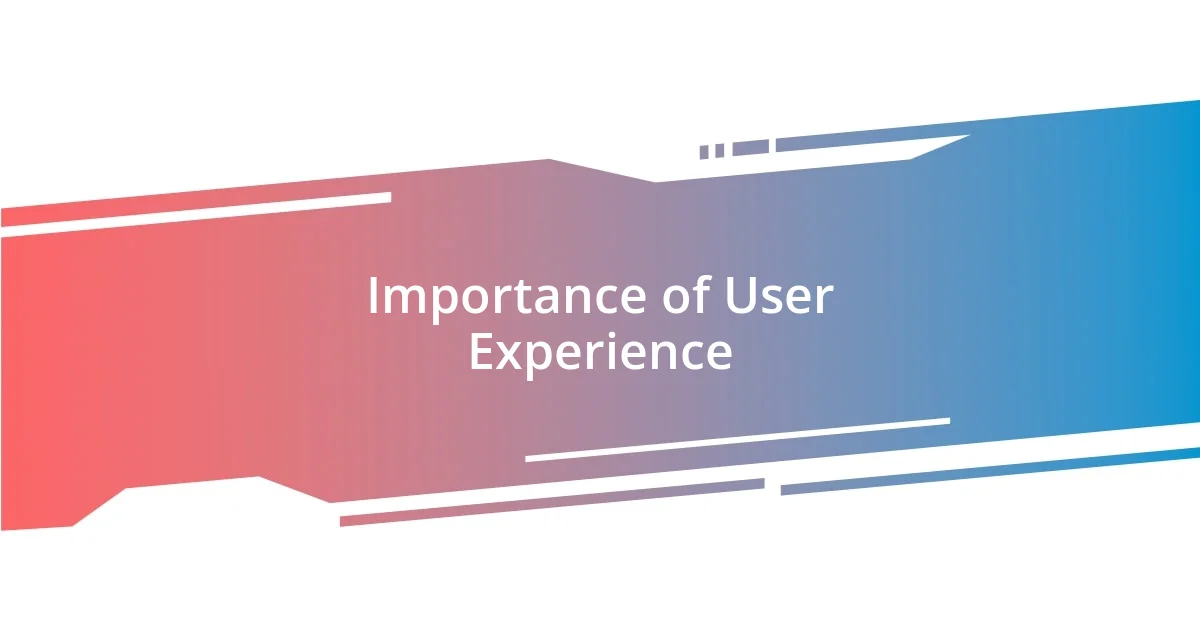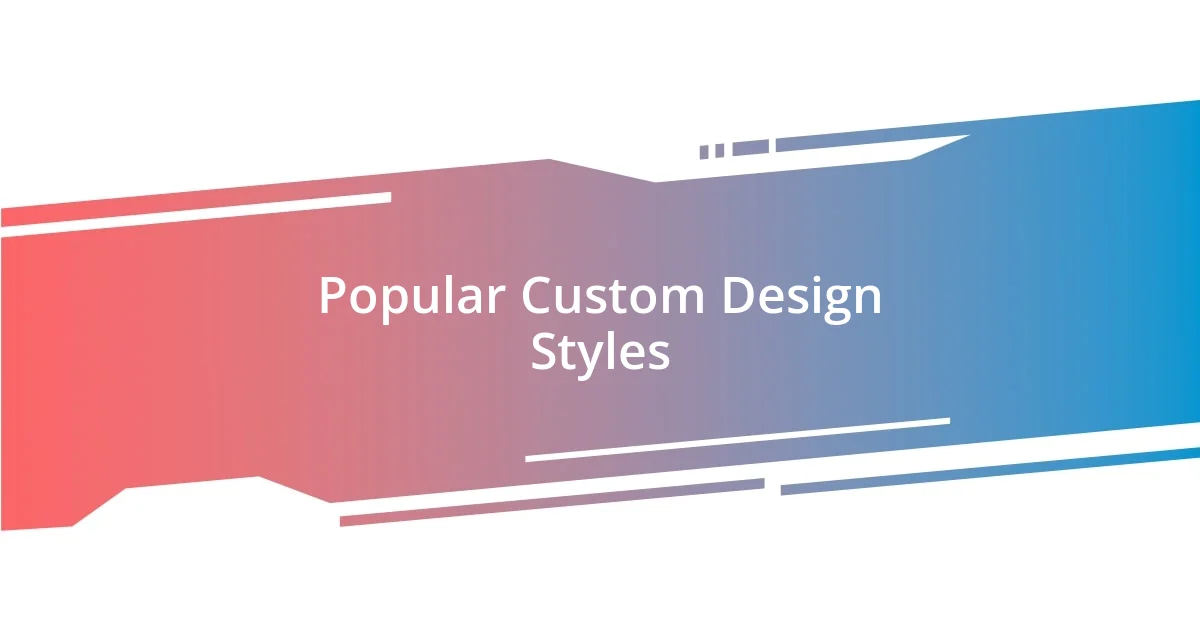Key takeaways:
- Custom design trends reflect cultural shifts, emphasizing sustainability, personalization, and storytelling.
- User experience is crucial in design, promoting engagement and emotional connections through intuitive and functional layouts.
- The future of custom design will focus on greater personalization, technological integration like augmented reality, and sustainability in materials.

Understanding Custom Design Trends
When I first dove into the world of custom design, I was struck by how trends can reflect deeper cultural shifts. For example, the rising popularity of sustainability in design speaks volumes about our collective consciousness and desire for eco-friendly choices. Have you ever paused to consider how the shift toward minimalism isn’t just about style, but also about simplifying our lives?
I’ve noticed that custom design trends often focus on individual stories and unique personalization. In my experience, creating a space that resonates personally helps reinforce one’s identity—like when I transformed a corner of my living room into a gallery for my travels, blending aesthetics with cherished memories. This trend of storytelling in design creates emotional connections, don’t you think?
Trends can sometimes feel ephemeral, but understanding their roots can provide significant insight. For instance, the revival of handcrafted elements in design evokes a sense of nostalgia and warmth. It reminds me of my grandmother’s handmade quilts, each square telling a different story. Isn’t it fascinating how trends can bridge generations, allowing us to connect with our past while shaping our future?

Importance of User Experience
User experience (UX) is paramount in custom design. From my own projects, I’ve realized a well-thought-out UX can elevate an average design into something truly unforgettable. One time, I redesigned a website for a small business, focusing on user-friendly navigation and intuitive graphics, which ultimately led to a significant increase in user engagement.
- Effective UX simplifies interaction.
- Personalized experiences foster emotional connections.
- Intuitive designs reduce frustration and enhance satisfaction.
- Positive experiences encourage return visits and referrals.
- Thoughtful design choices demonstrate care for the user’s needs.
When I think about the importance of UX, I’m reminded of a recent experience at a café where the layout was both beautiful and functional. As soon as I walked in, I felt welcomed by both the aesthetics and the seamless flow of the space. It’s amazing how something so simple can create a memorable experience and keep customers coming back. A great user experience doesn’t just promote usability; it cultivates a bond that brings people back to a place, both physically and digitally.

Popular Custom Design Styles
Popular Custom Design Styles cover a range of aesthetics that resonate with different tastes and preferences. One standout style is Bohemian, which celebrates a carefree and eclectic vibe, often incorporating vibrant colors and diverse patterns. I remember visiting a friend’s apartment adorned with mixed textiles and handcrafted decorations; it felt like stepping into a cozy, lived-in treasure chest. This style truly embodies the idea of personal expression through artfully curated chaos.
Another popular choice I’ve observed is Industrial design, focusing on raw materials and urban elements. Picture this: exposed brick walls, metal fixtures, and wooden accents coming together to create an inviting yet edgy atmosphere. When I renovated my own workspace, I embraced the industrial vibe, adding vintage furnishings alongside modern technology. The result was an environment that inspired creativity while maintaining a touch of rugged charm.
Lastly, the Scandinavian style has gained considerable traction for its emphasis on minimalism and functionality. With clean lines and a light color palette, this style promotes a sense of tranquility and order in life. I once transformed my bedroom by integrating Scandinavian elements; it was refreshing to see how decluttering and smart design choices could create a more peaceful haven. The beauty of these custom design styles lies in their ability to reflect who we are at a fundamental level, don’t you think?
| Design Style | Key Characteristics |
|---|---|
| Bohemian | Eclectic patterns, vibrant colors, and personalized decor |
| Industrial | Raw materials, exposed elements, and a rugged aesthetic |
| Scandinavian | Minimalism, functionality, and light color palettes |

Key Elements of Good Design
When I think about the key elements of good design, one stands out: balance. It’s fascinating how visual harmony can create an inviting space. In my experience redesigning a friend’s living room, I placed a large couch opposite a beautifully framed piece of art, which generated a sense of equilibrium and made the room feel both comfortable and purposeful. Do you ever notice how a well-balanced space can affect your mood?
Another essential aspect is color. Colors have a way of evoking emotions and setting the tone for a space. A few years ago, I painted my office a soft, calming blue, and it transformed my work environment. It’s amazing how that simple shade made me feel more focused and relaxed while working on projects. Have you ever experienced the impact of color in your own spaces?
Finally, I believe in the importance of functionality in design. A beautiful piece can go unnoticed if it doesn’t serve a purpose. I once crafted a bookshelf that doubled as a divider in a small studio apartment, blending style with practicality. It was rewarding to see how such a functional piece enhanced my friend’s living space without sacrificing aesthetics. Isn’t it incredible how good design can create harmony between beauty and usability?

Tools for Custom Design Projects
When it comes to tools for custom design projects, I’ve found that the right software can make all the difference. I remember diving into a new kitchen remodel and discovering 3D modeling tools like SketchUp. This software allowed me to visualize different layouts and finishes before making any commitments. Have you ever experienced the thrill of seeing your ideas come to life in three dimensions? It feels like stepping into your future space, doesn’t it?
Another essential tool I frequently use is mood board software. I recall a project where I was tasked with redesigning a small café. Using tools like Canva, I could gather color swatches, textures, and images of furniture all in one place. This process not only helped me communicate my vision to the client but also sparked new ideas as I played with different combinations. Have you ever created a mood board? It’s a creative way to capture the essence of your design concept.
Lastly, never underestimate the power of collaboration tools. During a group project, I used platforms like Trello to manage tasks and deadlines. It was enlightening to see how keeping everyone on the same page can enhance creativity and efficiency. I find that when team members are encouraged to share ideas, the outcome is inevitably richer. Don’t you think a collaborative approach can spark innovation in custom design projects?

Tips for Implementing Trends
One of my favorite tips for implementing trends in design is to start small. When I was eager to adopt the recent biophilic design trend, I decided to add a few potted plants to my workspace instead of a total overhaul. This small addition not only brought a refreshing burst of life to my environment but also significantly enhanced my mood and productivity. Have you ever tried integrating a trend in a minimal way? The satisfaction of noticing its impact can be surprisingly rewarding.
Don’t be afraid to mix and match elements from different trends. I remember experimenting with the minimalist trend alongside vintage decor in my living room. The sleek, clean lines of modern furniture paired beautifully with rustic pieces, creating a space that felt uniquely me. This blend not only reflected my personal style but also engaged my guests in conversation. Have you thought about how layering different trends could express your individuality?
Lastly, keep an eye on sustainability when implementing new trends. Recently, I embraced upcycled materials for a decorative project, transforming old wood into a stunning wall art piece. It felt fantastic to contribute positively to the environment while still staying on-trend. Engaging with eco-friendly design practices can be fulfilling, don’t you agree? Each choice we make can resonate with a broader purpose in our living spaces.

Future of Custom Design Trends
The future of custom design trends is undeniably exciting. I envision a growing emphasis on personalization, where every design tells a unique story about the individual or brand behind it. Recently, while working on a bespoke furniture piece for a client, I realized how tempting it can be to tailor every detail to reflect their personality. Have you ever felt that a space was truly yours because of the small, customized touches? That’s the magic that will continue to drive design forward.
In addition to personalization, technological advancements will shape the future landscape of custom design. Imagine using augmented reality to visualize changes in real-time. I had a moment while testing out AR technology for a project, where flipping through options while standing in the space felt revolutionary. It transformed how I approached design choices, making me wonder, how can we further integrate tech into our creative processes? This blend of digital and physical spaces opens up new dimensions in design thinking.
Sustainability is another trend that I believe will stay at the forefront of custom design. As a designer, I’ve started to incorporate more sustainable materials, like bamboo and recycled fabrics, into my projects. I once revamped a client’s space using reclaimed wood, and it not only looked gorgeous but also sparked conversations about environmental responsibility. How can we all contribute to a greener future through our design choices? Engaging thoughtfully with eco-friendly materials has a dual impact: enhancing aesthetics while fostering a deeper connection to our planet.















